Self-Healing UV-Curable Urethane (Meth)acrylates with Various Soft Segment Chemistry
Abstract
:1. Introduction
2. Materials and Methods
2.1. Materials
2.2. Synthesis of UA-DA Prepolymers
2.3. General Analytical Methods for Structural Confirmation
2.4. Formulation of Coating Compositions and Cured Films
2.5. Assessment of the Photopolymerization Process and Cured Coatings Properties
2.6. Investigation of Self-Healing Properties
3. Results and Discussion
3.1. Synthesis and Characterization of Urethane Acrylates
3.2. The UV Curing Process of Obtained Urethane (Meth)acrylates
3.3. Properties of Cured Coatings
3.4. Thermal Properties of Obtained Urethane (Meth)acrylates
3.5. Self-Healing Ability of Coatings Based on Urethane (Meth)acrylate Oligomers with Built-in DA Structure and Differences in the Length of the Soft Segment
4. Conclusions
Supplementary Materials
Author Contributions
Funding
Institutional Review Board Statement
Informed Consent Statement
Data Availability Statement
Conflicts of Interest
References
- Ren, J.; Zhu, Y.; Xuan, H.; Liu, X.; Lou, Z.; Ge, L. Highly Transparent and Self-Healing Films Based on the Dynamic Schiff Base Linkage. RSC Adv. 2016, 6, 115247–115251. [Google Scholar] [CrossRef]
- Chen, K.; Zhou, S.; Yang, S.; Wu, L. Fabrication of All-Water-Based Self-Repairing Superhydrophobic Coatings Based on UV-Responsive Microcapsules. Adv. Funct. Mater. 2015, 25, 1035–1041. [Google Scholar] [CrossRef]
- Nawrat, C.C.; Moody, C.J. Quinones as Dienophiles in the Diels–Alder Reaction: History and Applications in Total Synthesis. Angew. Chem. Int. Ed. 2014, 53, 2056–2077. [Google Scholar] [CrossRef] [PubMed]
- Zou, W.; Dong, J.; Luo, Y.; Zhao, Q.; Xie, T. Dynamic Covalent Polymer Networks: From Old Chemistry to Modern Day Innovations. Adv. Mater. 2017, 29, 1606100. [Google Scholar] [CrossRef] [PubMed]
- Sahoo, R.K.; Gothwal, A.; Rani, S.; Nakhate, K.T.; Ajazuddin; Gupta, U. PEGylated Dendrimer Mediated Delivery of Bortezomib: Drug Conjugation versus Encapsulation. Int. J. Pharm. 2020, 584, 119389. [Google Scholar] [CrossRef] [PubMed]
- Chen, X.; Sun, P.; Tian, H.; Li, X.; Wang, C.; Duan, J.; Luo, Y.; Li, S.; Chen, X.; Shao, J. Self-Healing and Stretchable Conductor Based on Embedded Liquid Metal Patterns within Imprintable Dynamic Covalent Elastomer. J. Mater. Chem. C 2022, 10, 1039–1047. [Google Scholar] [CrossRef]
- Zheng, N.; Xu, Y.; Zhao, Q.; Xie, T. Dynamic Covalent Polymer Networks: A Molecular Platform for Designing Functions beyond Chemical Recycling and Self-Healing. Chem. Rev. 2021, 121, 1716–1745. [Google Scholar] [CrossRef]
- Postiglione, G.; Turri, S.; Levi, M. Effect of the Plasticizer on the Self-Healing Properties of a Polymer Coating Based on the Thermoreversible Diels–Alder Reaction. Prog. Org. Coat. 2015, 78, 526–531. [Google Scholar] [CrossRef]
- Truong, T.T.; Thai, S.H.; Nguyen, H.T.; Phung, D.T.T.; Nguyen, L.T.; Pham, H.Q.; Nguyen, L.-T.T. Tailoring the Hard–Soft Interface with Dynamic Diels–Alder Linkages in Polyurethanes: Toward Superior Mechanical Properties and Healability at Mild Temperature. Chem. Mater. 2019, 31, 2347–2357. [Google Scholar] [CrossRef]
- Lee, T.Y.; Roper, T.M.; Jonsson, E.S.; Kudyakov, I.; Viswanathan, K.; Nason, C.; Guymon, C.A.; Hoyle, C.E. The Kinetics of Vinyl Acrylate Photopolymerization. Polymer 2003, 44, 2859–2865. [Google Scholar] [CrossRef]
- Khudyakov, I.V. Fast Photopolymerization of Acrylate Coatings: Achievements and Problems. Prog. Org. Coat. 2018, 121, 151–159. [Google Scholar] [CrossRef]
- Appuhamillage, G.A.; Chartrain, N.; Meenakshisundaram, V.; Feller, K.D.; Williams, C.B.; Long, T.E. 110th Anniversary: Vat Photopolymerization-Based Additive Manufacturing: Current Trends and Future Directions in Materials Design. Ind. Eng. Chem. Res. 2019, 58, 15109–15118. [Google Scholar] [CrossRef]
- Song, W.; Li, X.; Zhao, Y.; Liu, C.; Xu, J.; Wang, H.; Zhang, T. Functional, UV-Curable Coating for the Capture of Circulating Tumor Cells. Biomater. Sci. 2019, 7, 2383–2393. [Google Scholar] [CrossRef]
- Javadi, A.; Mehr, H.S.; Soucek, M.D. (Meth)Acrylated Poly(Ethylene Glycol)s as Precursors for Rheology Modifiers, Superplasticizers and Electrolyte Membranes: A Review: (Meth)Acrylated Poly(Ethylene Glycol) Precursors: A Review. Polym. Int. 2017, 66, 1765–1786. [Google Scholar] [CrossRef]
- Fu, J.; Wang, L.; Yu, H.; Haroon, M.; Haq, F.; Shi, W.; Wu, B.; Wang, L. Research Progress of UV-Curable Polyurethane Acrylate-Based Hardening Coatings. Prog. Org. Coat. 2019, 131, 82–99. [Google Scholar] [CrossRef]
- Tasic, S.; Bozic, B.; Dunjic, B. Synthesis of New Hyperbranched Urethane-Acrylates and Their Evaluation in UV-Curable Coatings. Prog. Org. Coat. 2004, 51, 320–327. [Google Scholar] [CrossRef]
- Zhang, Q.; Huang, C.; Wang, H.; Hu, M.; Li, H.; Liu, X. UV-Curable Coating Crosslinked by a Novel Hyperbranched Polyurethane Acrylate with Excellent Mechanical Properties and Hardness. RSC Adv. 2016, 6, 107942–107950. [Google Scholar] [CrossRef]
- Fałtynowicz, H.; Janik, H.; Kucinska-Lipka, J.; Sienkiewicz, M. Polyurethanes. In Handbook of Thermoset Plastics; Elsevier: Amsterdam, The Netherlands, 2022; pp. 231–262. ISBN 978-0-12-821632-3. [Google Scholar]
- Mehravar, S.; Ballard, N.; Tomovska, R.; Asua, J.M. Polyurethane/Acrylic Hybrid Waterborne Dispersions: Synthesis, Properties and Applications. Ind. Eng. Chem. Res. 2019, 58, 20902–20922. [Google Scholar] [CrossRef]
- Wang, Y.; Li, C.; Tuo, X.; Gong, Y.; Guo, J. Polyethylene Glycol Modified Epoxy Acrylate UV Curable 3D Printing Materials. J. Appl. Polym. Sci. 2021, 138, 50102. [Google Scholar] [CrossRef]
- Liu, X.; Wang, Z.; Zhu, J.; Zheng, Y.; Cui, S.; Lan, M.; Li, H. Synthesis, Characterization and Performance of a Polycarboxylate Superplasticizer with Amide Structure. Colloids Surf. A Physicochem. Eng. 2014, 448, 119–129. [Google Scholar] [CrossRef]
- Wang, Z.; Ma, Y.; Wang, Y.; Liu, Y.; Chen, K.; Wu, Z.; Yu, S.; Yuan, Y.; Liu, C. Urethane-Based Low-Temperature Curing, Highly-Customized and Multifunctional Poly(Glycerol Sebacate)-Co-Poly(Ethylene Glycol) Copolymers. Acta Biomater. 2018, 71, 279–292. [Google Scholar] [CrossRef]
- Huang, J.; Li, A.; Li, K. Investigation of Polyurethane-Based Pressure-Sensitive Adhesives with Castor Oil as a Polyol. Int. J. Adhes. Adhes. 2021, 105, 102763. [Google Scholar] [CrossRef]
- Zeng, L.; Song, W.; He, W.; Zhang, J.; Wang, Y.; Bian, J.; Mao, Z.; Quan, D.; Liu, J. Unconventional Passive Enhancement of Transdermal Drug Delivery: Toward a Mechanistic Understanding of Penetration Enhancers Releasing from Acrylic Pressure-Sensitive Adhesive of Patches. Pharm. Res. 2020, 37, 169. [Google Scholar] [CrossRef]
- Xu, J.; Feng, E.; Song, J. Bioorthogonally Cross-Linked Hydrogel Network with Precisely Controlled Disintegration Time over a Broad Range. J. Am. Chem. Soc. 2014, 136, 4105–4108. [Google Scholar] [CrossRef]
- McKinnon, D.D.; Brown, T.E.; Kyburz, K.A.; Kiyotake, E.; Anseth, K.S. Design and Characterization of a Synthetically Accessible, Photodegradable Hydrogel for User-Directed Formation of Neural Networks. Biomacromolecules 2014, 15, 2808–2816. [Google Scholar] [CrossRef]
- Zhang, Z.; Loebus, A.; de Vicente, G.; Ren, F.; Arafeh, M.; Ouyang, Z.; Lensen, M.C. Synthesis of Poly(Ethylene Glycol)-Based Hydrogels via Amine-Michael Type Addition with Tunable Stiffness and Postgelation Chemical Functionality. Chem. Mater. 2014, 26, 3624–3630. [Google Scholar] [CrossRef]
- Peng, F.; Liu, Y.; Li, X.; Sun, L.; Zhao, D.; Wang, Q.; Ma, G.; Su, Z. PEGylation of G-CSF in Organic Solvent Markedly Increase the Efficacy and Reactivity through Protein Unfolding, Hydrolysis Inhibition and Solvent Effect. J. Biotech. 2014, 170, 42–49. [Google Scholar] [CrossRef]
- Xue, X.; Ji, S.; Mu, Q.; Hu, T. Heat Treatment Increases the Bioactivity of C-Terminally PEGylated Staphylokinase. Process Biochem. 2014, 49, 1092–1096. [Google Scholar] [CrossRef]
- Pinguet, C.E.; Hoffmann, J.M.; Steinschulte, A.A.; Sybachin, A.; Rahimi, K.; Wöll, D.; Yaroslavov, A.; Richtering, W.; Plamper, F.A. Adjusting the Size of Multicompartmental Containers Made of Anionic Liposomes and Polycations by Introducing Branching and PEO Moieties. Polymer 2017, 121, 320–327. [Google Scholar] [CrossRef]
- Nemati, H.; Roghani-Mamaqani, H.; Salami-Kalajahi, M. Preparation of Polyurethane-Acrylate and Silica Nanoparticle Hybrid Composites by a Free Radical Network Formation Method. Bull. Mater. Sci. 2019, 42, 219. [Google Scholar] [CrossRef]
- Tungittiplakorn, W.; Kongbua, V.; Tulaphan, A.; Kaewtawee, K. Mobility of Polyethylene Glycol-Modified Urethane Acrylate (PMUA) Nanoparticles in Soils. E3S Web Conf. 2020, 141, 01002. [Google Scholar] [CrossRef]
- Izadi, M.; Mardani, H.; Roghani-Mamaqani, H.; Salami-Kalajahi, M.; Khezri, K. Hyperbranched Poly(Amidoamine)-Grafted Graphene Oxide as a Multifunctional Curing Agent for Epoxy-Terminated Polyurethane Composites. ChemistrySelect 2021, 6, 2692–2699. [Google Scholar] [CrossRef]
- Guan, T.; Du, Z.; Peng, J.; Zhao, D.; Sun, N.; Ren, B. Polymerizable Hydrophobically Modified Ethoxylated Urethane Acrylate Polymer: Synthesis and Viscoelastic Behavior in Aqueous Systems. Macromolecules 2020, 53, 7420–7429. [Google Scholar] [CrossRef]
- Chen, W.; Liu, P. Pegylated Dendritic Polyurethane as Unimolecular Micelles for Tumor Chemotherapy: Effect of Molecular Architecture. Int. J. Pharm. 2022, 616, 121533. [Google Scholar] [CrossRef]
- Xiang, H.; Wang, X.; Lin, G.; Xi, L.; Yang, Y.; Lei, D.; Dong, H.; Su, J.; Cui, Y.; Liu, X. Preparation, Characterization and Application of UV-Curable Flexible Hyperbranched Polyurethane Acrylate. Polymers 2017, 9, 552. [Google Scholar] [CrossRef]
- Wang, Z.; Yang, H.; Fairbanks, B.D.; Liang, H.; Ke, J.; Zhu, C. Fast Self-Healing Engineered by UV-Curable Polyurethane Contained Diels-Alder Structure. Prog. Org. Coat. 2019, 131, 131–136. [Google Scholar] [CrossRef]
- Ke, X.; Liang, H.; Xiong, L.; Huang, S.; Zhu, M. Synthesis, Curing Process and Thermal Reversible Mechanism of UV Curable Polyurethane Based on Diels-Alder Structure. Prog. Org. Coat. 2016, 100, 63–69. [Google Scholar] [CrossRef]
- Zhengjian, Q.; Xiangxin, L.; Yueming, S.; Zhenyang, L. Synthesis, Characterization of a Novel Light Stable Cross-Linker—Isophorone Diisocyanate Terpolymer Composite. Polym.-Plast. Technol. Eng. 2006, 45, 953–956. [Google Scholar] [CrossRef]
- Hu, S.; He, S.; Wang, Y.; Wu, Y.; Shou, T.; Yin, D.; Mu, G.; Zhao, X.; Gao, Y.; Liu, J.; et al. Self-Repairable, Recyclable and Heat-Resistant Polyurethane for High-Performance Automobile Tires. Nano Energy 2022, 95, 107012. [Google Scholar] [CrossRef]
- Nowak, M.; Bednarczyk, P.; Mozelewska, K.; Czech, Z. Synthesis and Characterization of Urethane Acrylate Resin Based on 1,3-Propanediol for Coating Applications. Coatings 2022, 12, 1860. [Google Scholar] [CrossRef]
- Wan, T.; Chen, D. Synthesis and Properties of Self-Healing Waterborne Polyurethanes Containing Disulfide Bonds in the Main Chain. J. Mater. Sci. 2017, 52, 197–207. [Google Scholar] [CrossRef]
- Turkenburg, D.H.; Durant, Y.; Fischer, H.R. Bio-Based Self-Healing Coatings Based on Thermo-Reversible Diels-Alder Reaction. Prog. Org. Coat. 2017, 111, 38–46. [Google Scholar] [CrossRef]
- Liu, J.; Zhou, Z.; Su, X.; Cao, J.; Chen, M.; Liu, R. Stiff UV-Curable Self-Healing Coating Based on Double Reversible Networks Containing Diels-Alder Cross-Linking and Hydrogen Bonds. Prog. Org. Coat. 2020, 146, 105699. [Google Scholar] [CrossRef]
- Wang, Z.; Liang, H.; Yang, H.; Xiong, L.; Zhou, J.; Huang, S.; Zhao, C.; Zhong, J.; Fan, X. UV-Curable Self-Healing Polyurethane Coating Based on Thiol-Ene and Diels-Alder Double Click Reactions. Prog. Org. Coat. 2019, 137, 105282. [Google Scholar] [CrossRef]
- Bednarczyk, P.; Mozelewska, K.; Klebeko, J.; Rokicka, J.; Ossowicz-Rupniewska, P. Impact of the Chemical Structure of Photoreactive Urethane (Meth)Acrylates with Various (Meth)Acrylate Groups and Built-In Diels–Alder Reaction Adducts on the UV-Curing Process and Self-Healing Properties. Polymers 2023, 15, 924. [Google Scholar] [CrossRef]
- Lu, X.; Fei, G.; Xia, H.; Zhao, Y. Ultrasound Healable Shape Memory Dynamic Polymers. J. Mater. Chem. A 2014, 2, 16051–16060. [Google Scholar] [CrossRef]
- Syrett, J.A.; Mantovani, G.; Barton, W.R.S.; Price, D.; Haddleton, D.M. Self-Healing Polymers Prepared via Living Radical Polymerisation. Polym. Chem. 2010, 1, 102. [Google Scholar] [CrossRef]
- Heath, W.H.; Palmieri, F.; Adams, J.R.; Long, B.K.; Chute, J.; Holcombe, T.W.; Zieren, S.; Truitt, M.J.; White, J.L.; Willson, C.G. Degradable Cross-Linkers and Strippable Imaging Materials for Step-and-Flash Imprint Lithography. Macromolecules 2008, 41, 719–726. [Google Scholar] [CrossRef]
- Duran, H.; Meng, S.; Kim, N.; Hu, J.; Kyu, T.; Natarajan, L.V.; Tondiglia, V.P.; Bunning, T.J. Kinetics of Photopolymerization-Induced Phase Separation and Morphology Development in Mixtures of a Nematic Liquid Crystal and Multifunctional Acrylate. Polymer 2008, 49, 534–545. [Google Scholar] [CrossRef]
- Yin, B.; Zhang, J. A Novel Photocurable Modified Epoxy Resin for High Heat Resistance Coatings. Colloid Polym. Sci. 2020, 298, 1303–1312. [Google Scholar] [CrossRef]
- Bednarczyk, P.; Mozelewska, K.; Nowak, M.; Klebeko, J.; Rokicka, J.; Ossowicz-Rupniewska, P. Effect of Hard Segment Chemistry and Structure on the Self-healing Properties of UV -curable Coatings Based on the Urethane Acrylates with Built-in Diels–Alder Adduct. J. Appl. Polym. Sci. 2023, 140, e54266. [Google Scholar] [CrossRef]
- Wang, Y.; Wang, L.; Liu, H.; He, S.; Liu, X.; Liu, W.; Huang, M.; Zhu, C. Polyurethane as Smart Biocoatings: Effects of Hard Segments on Phase Structures and Properties. Prog. Org. Coat. 2021, 150, 106000. [Google Scholar] [CrossRef]
- Dudowicz, J.; Freed, K.F.; Douglas, J.F. The Glass Transition Temperature of Polymer Melts. J. Phys. Chem. B 2005, 109, 21285–21292. [Google Scholar] [CrossRef] [PubMed]
- Jean, Y.C. Positron Annihilation Spectroscopy for Chemical Analysis: A Novel Probe for Microstructural Analysis of Polymers. Microchem. J. 1990, 42, 72–102. [Google Scholar] [CrossRef]
- Zafar, F.; Ghosal, A.; Sharmin, E.; Chaturvedi, R.; Nishat, N. A Review on Cleaner Production of Polymeric and Nanocomposite Coatings Based on Waterborne Polyurethane Dispersions from Seed Oils. Prog. Org. Coat. 2019, 131, 259–275. [Google Scholar] [CrossRef]
- Zhang, E.; Shi, J.; Xiao, L.; Zhang, Q.; Lu, M.; Nan, B.; Wu, K.; Lu, M. A Highly Efficient Bionic Self-Healing Flexible Waterborne Polyurethane Elastic Film Based on a Cyclodextrin–Ferrocene Host–Guest Interaction. Polym. Chem. 2021, 12, 831–842. [Google Scholar] [CrossRef]
- An, R.; Zhang, X.; Han, L.; Wang, X.; Zhang, Y.; Shi, L.; Ran, R. Healing, Flexible, High Thermal Sensitive Dual-Network Ionic Conductive Hydrogels for 3D Linear Temperature Sensor. Mater. Sci. Eng. C 2020, 107, 110310. [Google Scholar] [CrossRef]
- Tong, X.; Tian, Z.; Sun, J.; Tung, V.; Kaner, R.B.; Shao, Y. Self-Healing Flexible/Stretchable Energy Storage Devices. Mater. Today 2021, 44, 78–104. [Google Scholar] [CrossRef]
- Wu, X.; Wang, J.; Huang, J.; Yang, S. Room Temperature Readily Self-Healing Polymer via Rationally Designing Molecular Chain and Crosslinking Bond for Flexible Electrical Sensor. J. Colloid Interface Sci. 2020, 559, 152–161. [Google Scholar] [CrossRef]
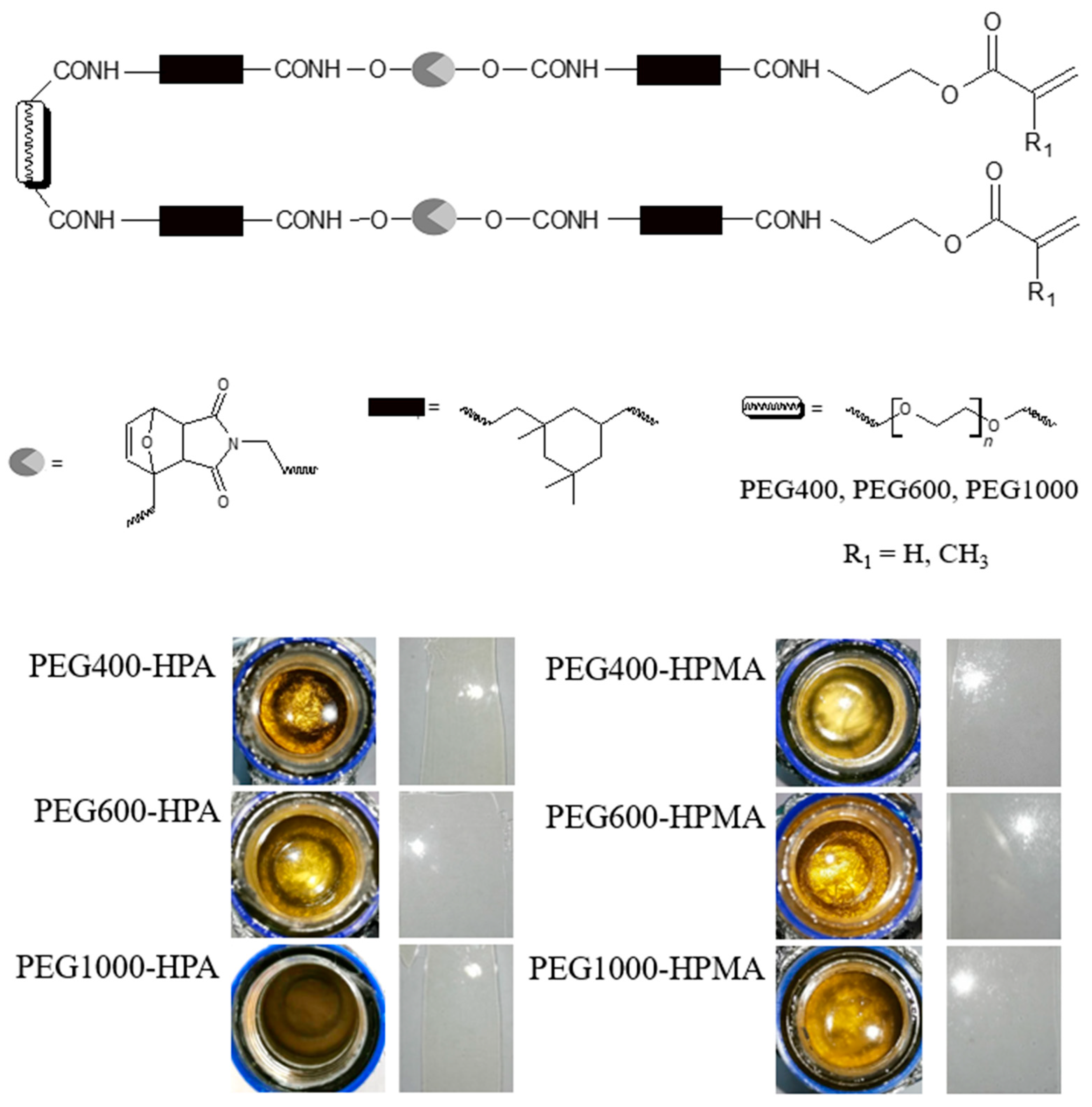
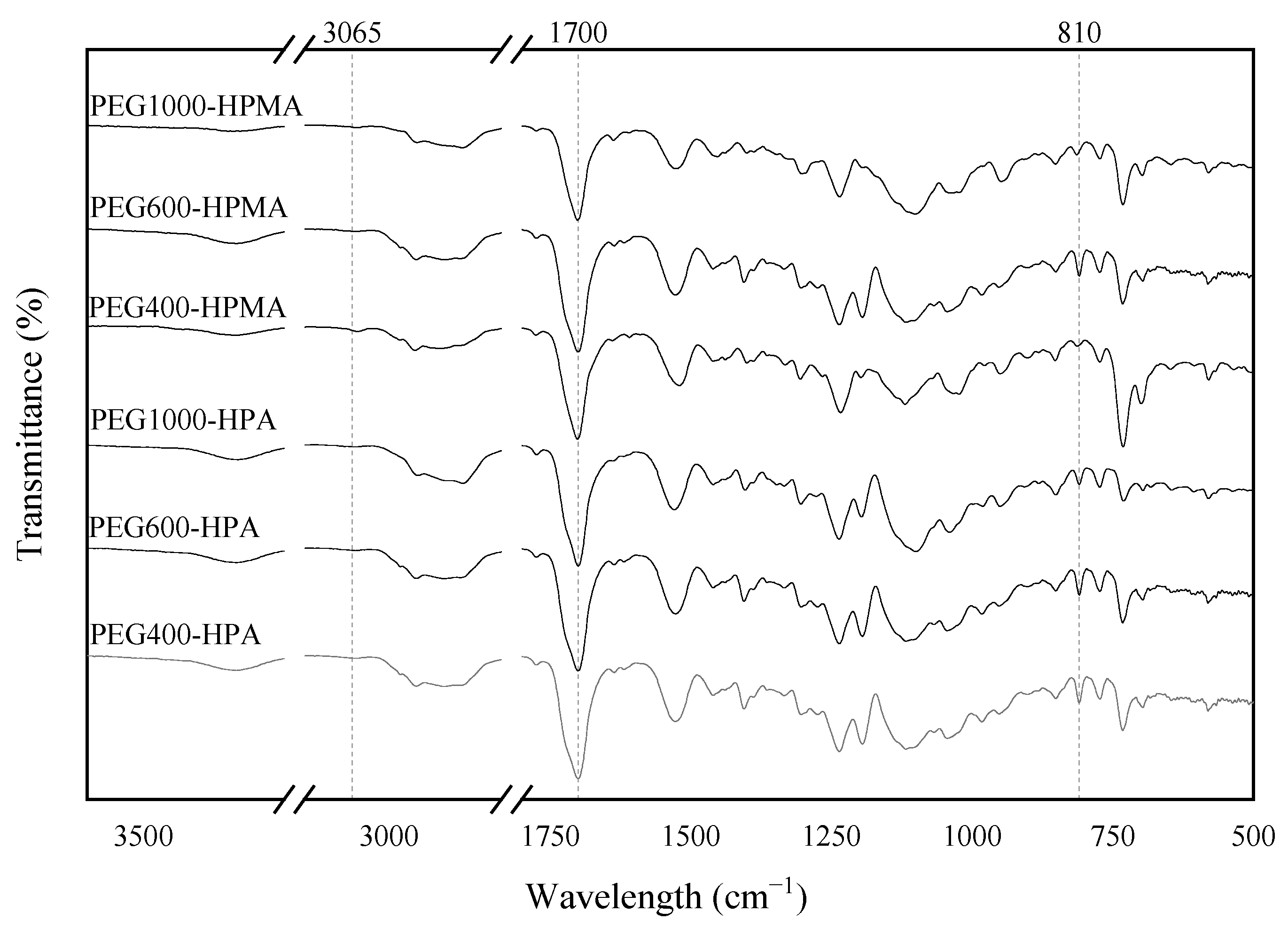
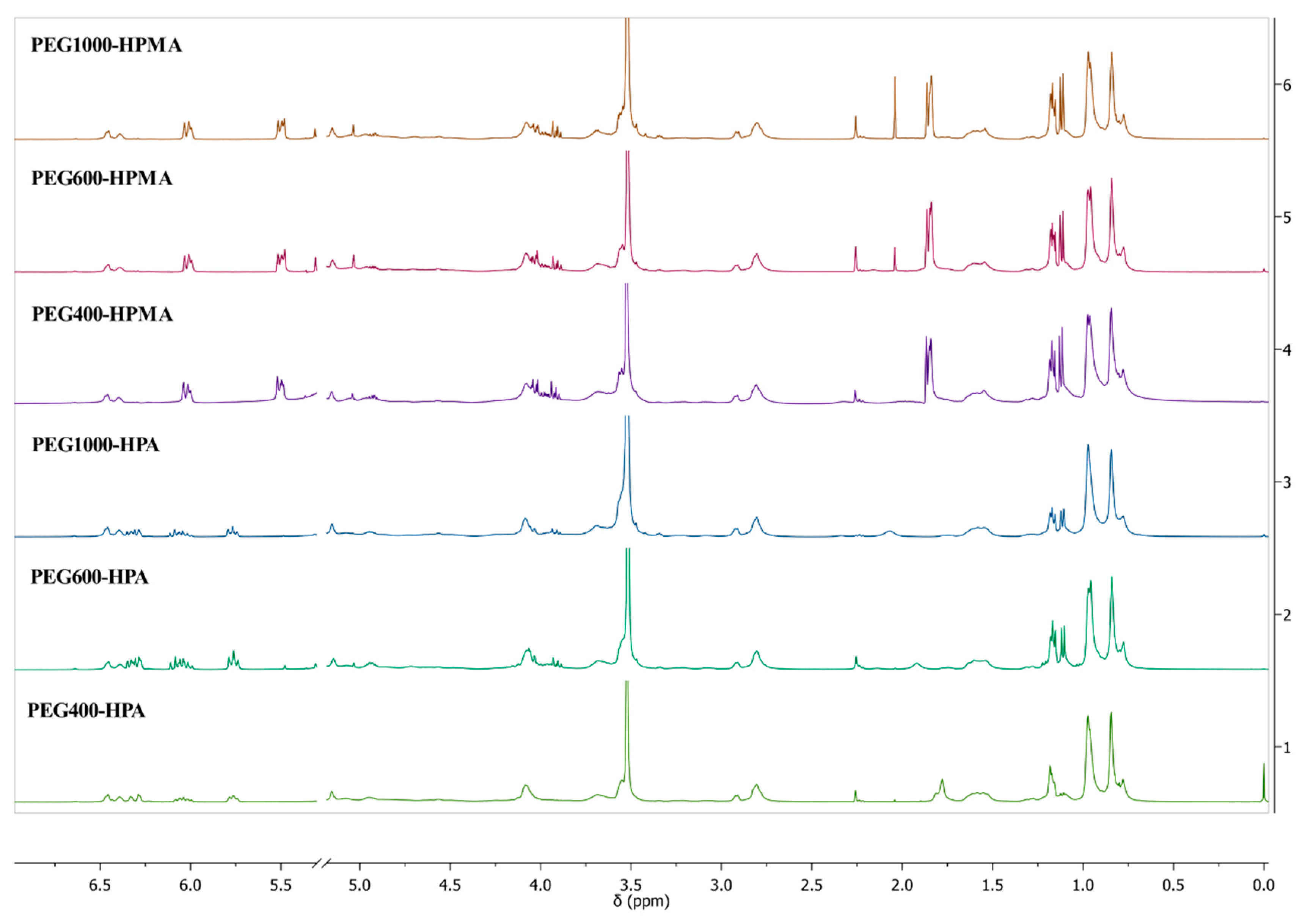


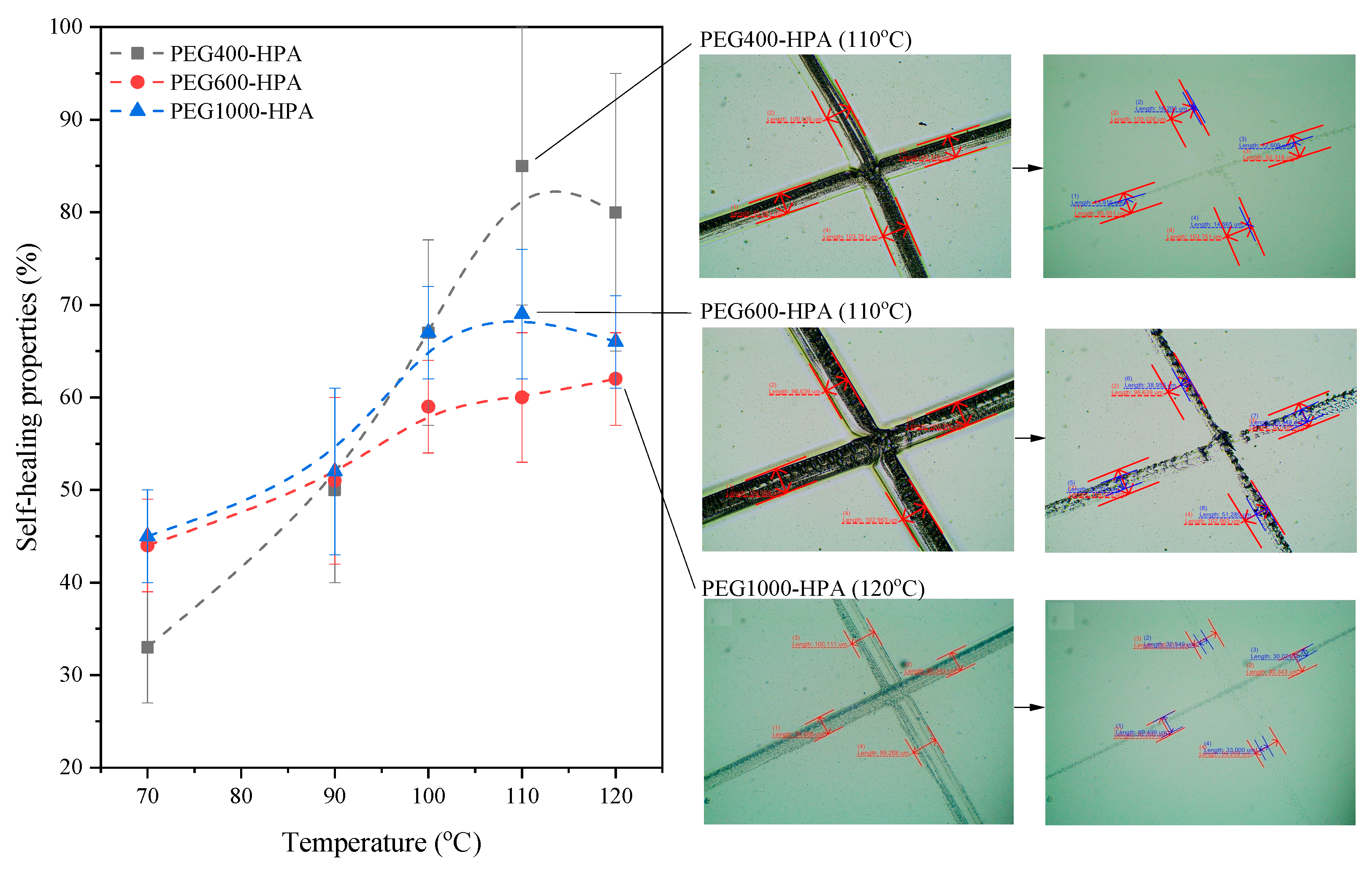
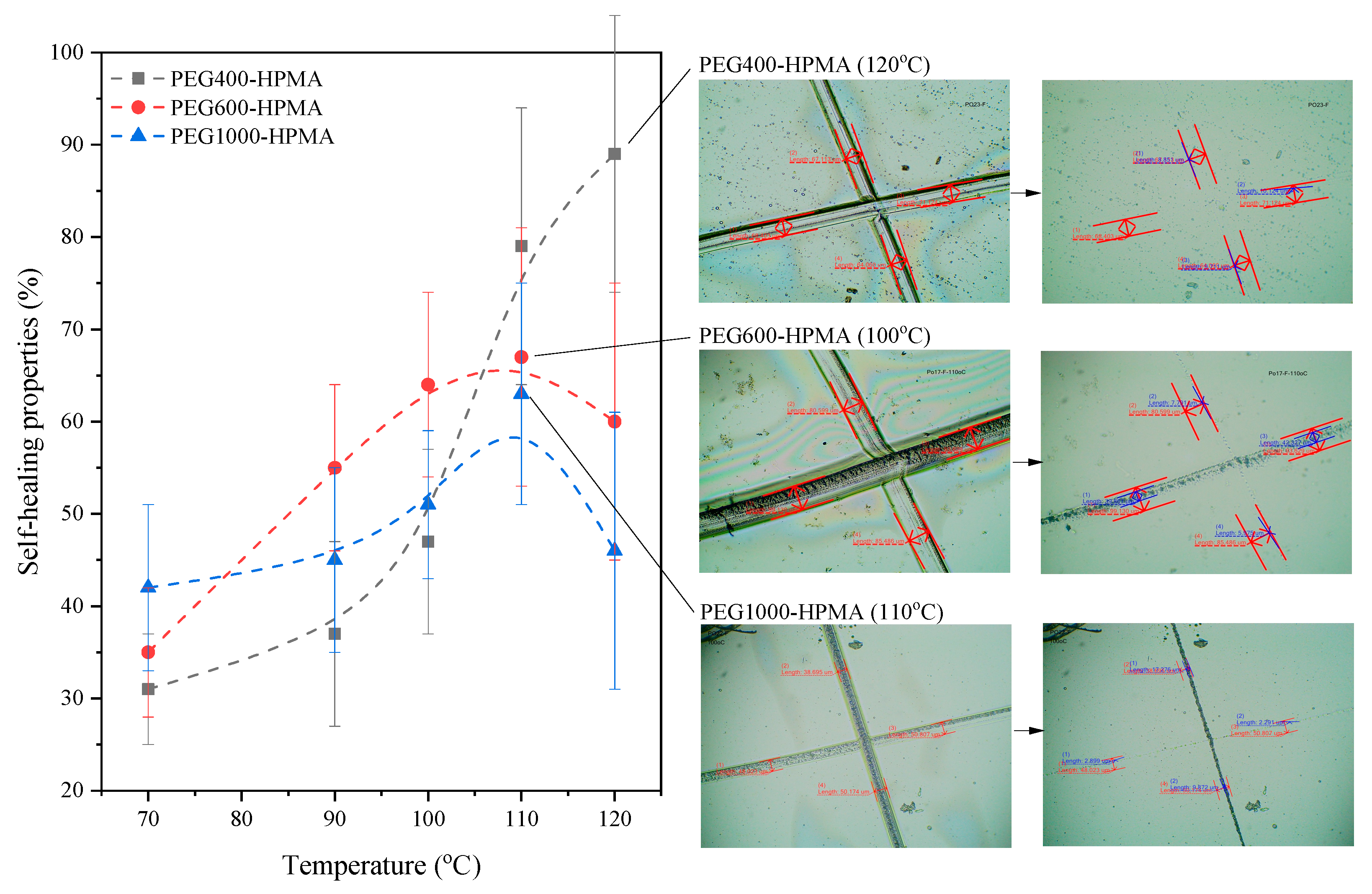
| Sample Code | mHODA (g) | mDD (g) | mIPDI (g) | MPEG | mPEG (g) | mDD (g) | HR(M)A | mHR(M)A | mDD (g) |
|---|---|---|---|---|---|---|---|---|---|
| PEG400-HPA | 9.98 | 0.26 | 18.53 | 400 | 8.34 | 0.25 | HPA | 5.42 | 0.33 |
| PEG600-HPA | 9.35 | 0.21 | 17.45 | 600 | 11.78 | 0.21 | HPA | 5.11 | 0.30 |
| PEG1000-HPA | 9.33 | 0.31 | 17.35 | 1000 | 19.51 | 0.26 | HPA | 5.07 | 0.31 |
| PEG400-HPMA | 9.52 | 0.26 | 17.70 | 400 | 7.96 | 0.29 | HPMA | 5.73 | 0.34 |
| PEG600-HPMA | 9.47 | 0.21 | 17.59 | 600 | 11.87 | 0.22 | HPMA | 5.70 | 0.33 |
| PEG1000-HPMA | 9.23 | 0.21 | 16.92 | 1000 | 19.03 | 0.22 | HPMA | 5.49 | 0.27 |
| Sample Code | ΔHtotal (J/g) | tmax (s) | DCmax (%) | Rpmax (%/min) |
|---|---|---|---|---|
| PEG400-HPA | 290 | 1.8 | 57 | 128 |
| PEG600-HPA | 232 | 7.8 | 83 | 89 |
| PEG1000-HPA | 139 | 8.4 | 89 | 61 |
| PEG400-HPMA | 435 | 4.2 | 32 | 27 |
| PEG600-HPMA | 451 | 4.2 | 67 | 57 |
| PEG1000-HPMA | 465 | 4.2 | 86 | 71 |
| Sample Code | Tack-Free Time (s) | Hardness | Adhesion | Gloss (GU) | Yellowness Index |
|---|---|---|---|---|---|
| PEG400-HPA | 3 | 70 | 2.5 | 146 | 5.4 |
| PEG600-HPA | 3 | 65 | 2.0 | 151 | 5.4 |
| PEG1000-HPA | 6 | 58 | 1.0 | 166 | 5.5 |
| PEG400-HPMA | 3 | 131 | 2.5 | 103 | 4.3 |
| PEG600-HPMA | 3 | 119 | 1.5 | 150 | 3.9 |
| PEG1000-HPMA | 6 | 111 | 1.5 | 151 | 3.6 |
| Sample Code | TIDT (°C) | TMDT (°C) |
|---|---|---|
| PEG400-HPA | 291.2 | 324.0 |
| PEG600-HPA | 283.1 | 321.7 |
| PEG1000-HPA | 274.3 | 317.9 |
| PEG400-HPMA | 290.8 | 324.6 |
| PEG600-HPMA | 291.3 | 328.3 |
| PEG1000-HPMA | 307.5 | 331.9 |
Disclaimer/Publisher’s Note: The statements, opinions and data contained in all publications are solely those of the individual author(s) and contributor(s) and not of MDPI and/or the editor(s). MDPI and/or the editor(s) disclaim responsibility for any injury to people or property resulting from any ideas, methods, instructions or products referred to in the content. |
© 2023 by the authors. Licensee MDPI, Basel, Switzerland. This article is an open access article distributed under the terms and conditions of the Creative Commons Attribution (CC BY) license (https://creativecommons.org/licenses/by/4.0/).
Share and Cite
Bednarczyk, P.; Ossowicz-Rupniewska, P.; Klebeko, J.; Rokicka, J.; Bai, Y.; Czech, Z. Self-Healing UV-Curable Urethane (Meth)acrylates with Various Soft Segment Chemistry. Coatings 2023, 13, 2045. https://doi.org/10.3390/coatings13122045
Bednarczyk P, Ossowicz-Rupniewska P, Klebeko J, Rokicka J, Bai Y, Czech Z. Self-Healing UV-Curable Urethane (Meth)acrylates with Various Soft Segment Chemistry. Coatings. 2023; 13(12):2045. https://doi.org/10.3390/coatings13122045
Chicago/Turabian StyleBednarczyk, Paulina, Paula Ossowicz-Rupniewska, Joanna Klebeko, Joanna Rokicka, Yongping Bai, and Zbigniew Czech. 2023. "Self-Healing UV-Curable Urethane (Meth)acrylates with Various Soft Segment Chemistry" Coatings 13, no. 12: 2045. https://doi.org/10.3390/coatings13122045
APA StyleBednarczyk, P., Ossowicz-Rupniewska, P., Klebeko, J., Rokicka, J., Bai, Y., & Czech, Z. (2023). Self-Healing UV-Curable Urethane (Meth)acrylates with Various Soft Segment Chemistry. Coatings, 13(12), 2045. https://doi.org/10.3390/coatings13122045









